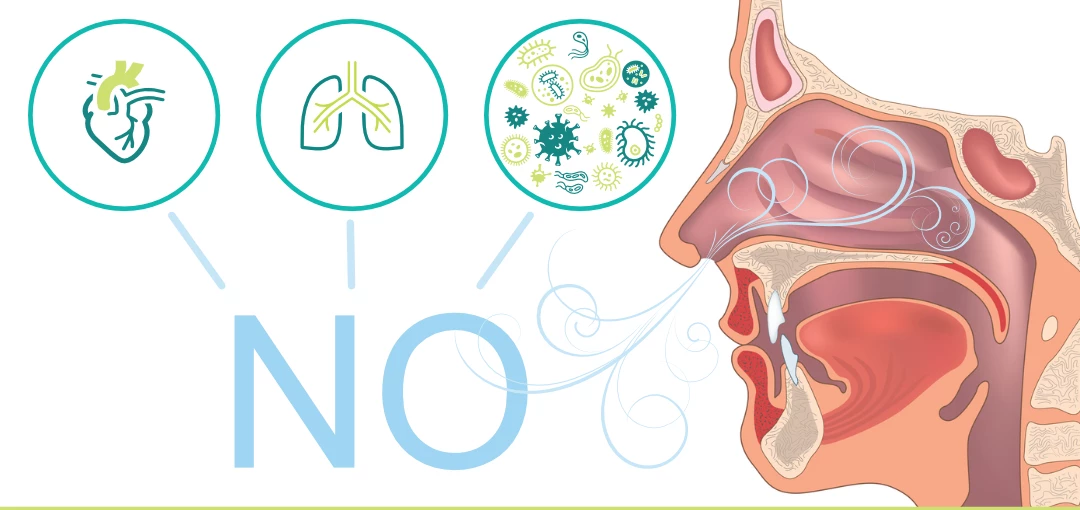The Many Health Benefits of Nitric Oxide and How Yoga May Help Increase It

It is often referred to as “the miracle molecule” you have never heard of – a wonder substance that can improve the functioning of a vast number of vital processes in the body.
Low levels of nitric oxide is known to increase the risk of high blood pressure, coronary artery disease, impaired vision, depression, cognitive decline and other health issues.
But the good news? Research suggests that there are ways to enhance nitric oxide production and yogic breathing practices can play a role. Read on below!
Nitric oxide was discovered in the 1990s by Louis J. Ignarro, Ph.D., a medical research scientist. He was subsequently awarded the Nobel Prize in Physiology or Medicine for his discoveries of how nitric oxide positively impacts health and longevity. Dr. Ignarro writes:
“Nitric oxide, also termed NO, is a gaseous molecule that is produced by our arteries in all organs to regulate cardiovascular function. Nitric oxide causes the muscle cells (smooth muscle) enveloping arteries to relax, thereby causing vasodilation, or widening of the arteries. This physiological action results in a decrease in blood pressure within the arteries and increased blood flow to all organs through the dilated arteries.” (2) Through that action nitric oxide protects us against hypertension, heart attacks, and strokes. This quality of nitric oxide is also used in drugs like Viagra to dilate the arteries within the erectile tissue.
Nitric oxide also relaxes smooth muscles in the trachea and bronchioles of the lungs, enabling us to breathe better. Small doses of nitric oxide given to newborn babies who had constricted pulmonary arteries result in an immediate and permanent reversal of hypertension. “In 1999, the FDA approved inhaled NO for PPHN [Persistent pulmonary hypertension of the newborn]. Today, it saves around 25,000 infants every year in the U.S.” (3)
In addition, nitric oxide contributes to immunological defense against bacterial, viral, fungal, and parasitic infections in the body. “Nitric oxide reacts chemically with certain other molecules in cells to alter their function. The NO produced by our own cells can interact with molecules in invading cells such as bacteria, parasites, and viruses to kill them or inhibit their replication or spread.” (2) This is how nitric oxide is being used in the latest research to stop the spread of COVID-19.

In 2004 it had been shown in laboratory conditions that NO could increase the rate of survival of mammalian cells infected with the original SARS-CoV (4). There is currently a study underway that follows 470 healthcare professionals who care for patients with proven SARS-CoV-2 infection. Some of them are regularly inhaling nitric oxide before and after their shift to see if it can protect healthcare professionals from contracting the virus. (5) Another study is testing whether or not inhaled nitric oxide helps with oxygenation in mechanically ventilated patients with COVID-19. (6) The latest nitric oxide trials by KNOW Bio build on that, although their research is still miles away from being proven to be safe and effective for humans.
Can We Increase nitric Oxide? TryYogic Breathing and Humming
Sufficient levels of nitric oxide are necessary for the proper functioning of our circulatory, respiratory and immune systems. The good news is that our bodies naturally produce this gas and we can increase its production by doing two very simple things:
1. Breathe Through Your Nose
In addition to filtering out particles of dirt and pathogens, warming the air, and controlling the air stream, the cells and tissues in the nose continuously and reliably produce nitric oxide. “The physiological significance of this is that nasally-derived NO improves oxygen delivery into the lungs by causing bronchodilation—the relaxation and widening of the bronchi and bronchioles in the lungs.”(2)
When you practice yoga asana, notice whether you tend to breathe through your nose or through your mouth. If you find yourself mouth breathing, you may be pushing too hard. Ease up and relax your breathing.
2. Hum a Tune
Humming greatly increases the levels of nitric oxide in the nose. Research had shown that “Nitric oxide increased 15-fold during humming compared with quiet exhalation. […] This effect is likely due to the increased contribution of NO from the paranasal sinuses. Humming causes the air to oscillate, which in turn seems to increase the exchange of air between the sinuses and the nasal cavity.”
Humming is a simple, yet fascinating thing. So far it has been shown to:
- Increase nitric oxide production
- Alleviate chronic inflammation or infection of the nose and sinuses
- Promote limbic deactivation, taking the edge off our basic emotions (fear, pleasure, anger) and drives (hunger, sex, dominance, care of offspring). [This effect was shown after chanting OM, which has the same resonant qualities as humming]
- Lead to parasympathetic (rest-and-digest) predominance, which manifests as a reduction in heart rate and BP, improvement in cognition, reduction in irritability in tinnitus, favorable EEG changes, and reduction in stress levels (
- Improve pulmonary function in healthy individuals
Try it for yourself. Hum your favorite tune throughout the day and see how it makes you feel. In addition, all these effects can be amplified when humming is combined with certain common yoga practices—extended exhalation and contemplative awareness.
3. Try Bhramari Pranayam (Bees Breath)
Recent research suggests that the practice of Bhramari Pranayam can be effective at increasing nitric oxide. Essentially a different type of humming, there is research evidence that Bhramari Pranayam may also help with reducing heart rate, increasing heart rate variability, and improving lung function. It may also help to calm the mind, heighten awareness, and balance the nervous system
Also, read...
4 Yogic Tips to Make your New Year’s Resolutions Stick
Yoga for Mindful Eating: 12 Tips for Practicing Presence While You Eat
Healthy Chocolate Truffles
Related courses

Educated as a school teacher, Olga Kabel has been teaching yoga for over 14 years. She completed multiple Yoga Teacher Training Programs but discovered the strongest connection to the Krishnamacharya/ T.K.V. Desikachar lineage. She had studied with Gary Kraftsow and American Viniyoga Institute (2004-2006) and received her Viniyoga Teacher diploma in July 2006, becoming an AVI-certified Yoga Therapist in April 2011. Olga is a founder and managing director of Sequence Wiz— a web-based yoga sequence builder that assists yoga teachers and yoga therapists in creating and organizing yoga practices. It also features simple, informational articles on how to sequence yoga practices for maximum effectiveness. Olga strongly believes in the healing power of this ancient discipline on every level: physical, psychological, and spiritual. She strives to make yoga practices accessible to students of any age, physical ability, and medical history, specializing in helping her students relieve muscle aches and pains, manage stress and anxiety, and develop mental focus.
- Humming Greatly Increases Nasal Nitric Oxide by Eddie Weitzberg and Jon O. N. Lundberg
- Strong humming for one hour daily to terminate chronic rhinosinusitis in four days: a case report and hypothesis for action by stimulation of endogenous nasal nitric oxide production by George A Eby
- Neurohemodynamic correlates of ‘OM’ chanting: A pilot functional magnetic resonance imaging study by Bangalore G Kalyani, et al
- Effects of Bhramari Pranayama on health – A systematic review by Maheshkumar Kuppusamy
- Effect of Bhramari pranayama and OM chanting on pulmonary function in healthy individuals: A prospective randomized control trial by A Mooventhan and Vitthal Khode



